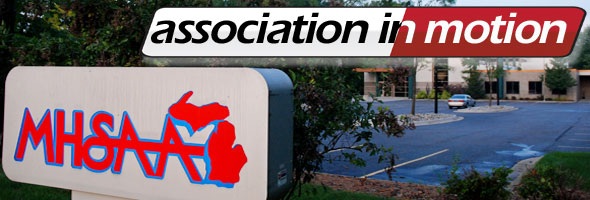
Representative Council Wrap-up: Fall
December 20, 2011
EAST LANSING – The appointment of its newest member and the adoption of four lacrosse regulations were among actions taken by the Representative Council of the Michigan High School Athletic Association during its annual Fall Meeting, Dec. 2, in East Lansing.
Yale Public Schools athletic director Maureen E. Klocke was appointed to the 19-member council for a two-year term and brings with her more than 16 years experience as an athletic administrator.
She’s served in her current position since August 2005, and during her tenure has led in the hosting of MHSAA post-season tournaments for eight sports, including Regionals for girls basketball and volleyball. Previously, Klocke served as Capac’s athletic director for nine years and prior to that was interim athletic director for Memphis schools for seven months. She also coached basketball, volleyball and softball during her time at Memphis.
Also, Perry High School principal Paula Steele was re-appointed for a two-year term. Steele joined Perry’s district this summer after previously serving in the same position at East Lansing High School.
The Representative Council is the legislative body of the MHSAA. All but five members are elected by member schools. Four members are appointed by the Council to facilitate representation of females and minorities; and the 19th position is occupied by the Superintendent of Public Instruction or designee.
Also at the Fall Meeting, the following Girls Lacrosse Committee recommendations were adopted for the 2012 season:
--A game interrupted by events beyond the control of authorities may be continued from that point of interruption either later that day or on another date. This alters a national women’s lacrosse rule stating an interrupted game must be played from the beginning if rescheduled for another date. A game continued over two days will count as just one date on those teams’ schedules, while it will count as two of the team’s scheduling dates if the game is played, interrupted, and then played from the beginning on another day.
--Teams may play two regulation games in one day, to not exceed 120 total minutes played. This is in addition to the current rule allowing three games in one day with not more than 20-minute halves. This addresses a preference by some teams to play two full games at a tournament instead of three shortened games.
--A student or coach disqualified for unsportsmanlike conducted must be withheld by her or his school for at least the next day of competition for that team, consistent with MHSAA rules for other sports. This alters the national women’s lacrosse rule stating those who are disqualified must be withheld from the next two games.
--The unruly actions of spectators will not result in a card being assessed to their team’s coach. The national rule does assess a card to the head coach as punishment for spectator misconduct.
The MHSAA is a private, not-for-profit corporation of voluntary membership by over 1,500 public and private senior high schools and junior high/middle schools which exists to develop common rules for athletic eligibility and competition. No government funds or tax dollars support the MHSAA, which was the first such association nationally to not accept membership dues or tournament entry fees from schools. Member schools which enforce these rules are permitted to participate in MHSAA tournaments, which attract approximately 1.6 million spectators each year.

Pay-to-Play Down Slightly, Survey Shows
July 24, 2018
By Geoff Kimmerly
Second Half editor
Slightly less than 50 percent of MHSAA member high schools assessed sports participation fees during the 2017-18 school year, according to an annual survey that enjoyed its highest response rate in 14 years of measuring the prevalence of charging students to help fund interscholastic athletics.
This year’s survey was completed by a record 80 percent of the MHSAA’s 751 member high schools, and 49 percent of respondents charged participation fees – down slightly from 49.7 percent in 2016-17, when the rate dropped below 50 percent for the first time since 2009-10.
The MHSAA conducted its first participation fee survey during the 2003-04 school year, when 24 percent of responding schools reported they charged fees. The percentage of member schools charging fees crossed 50 percent in 2010-11 and reached a high of 56.6 percent in 2013-14.
Class A schools remained the largest group charging fees in 2017-18, with 65 percent of respondents doing so – although that percentage was the lowest for Class A since 66 percent reported using fees in 2011-12. Class B schools fell to 47 percent charging fees (from 52 percent in 2016-17), while Class C (46 percent) and Class D (37) schools remained below 50 percent as well.
Charging a standardized fee for each team on which a student-athlete participates – regardless of the number of teams – remains the most popular method among schools assessing fees, with that rate at 43 percent of schools. Schools charging a one-time standardized fee per student-athlete showed a slight decrease to 28 percent, while assessing fees based on tiers of the number of sports a student-athlete plays (for example, charging a larger fee for the first team and less for additional sports) and assessing fees based on the specific sport being played (some being more expensive than others) both showed slight upticks to 15 and 5 percent, respectively.
The amounts of most fees remained consistent during 2017-18: the median annual maximum fee per student at $150, the median annual maximum family fee at $300 and the median per-team fee at $75 – all for at least the fourth straight year. The median fee assessed by schools that charge student-athletes once per year held steady at $125 for the second straight school year.
Click for the survey for 2017-18, and surveys from previous years can be found here.

